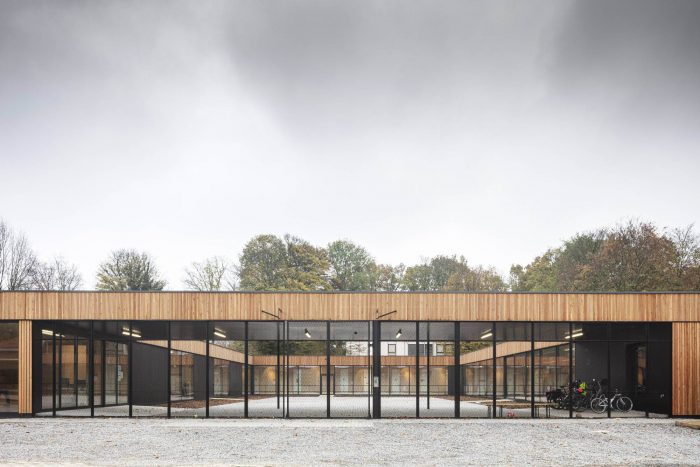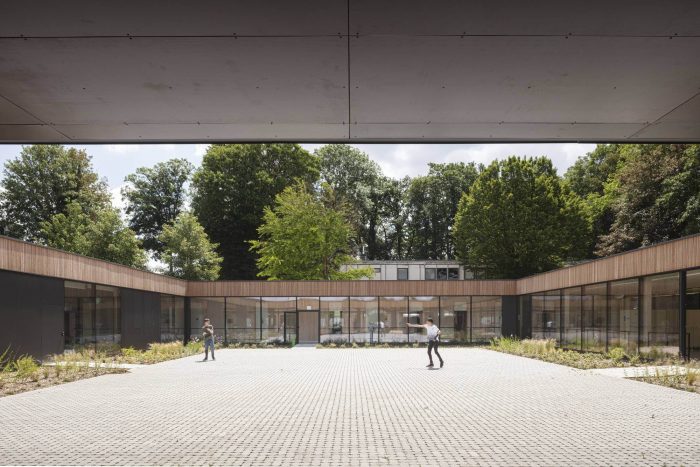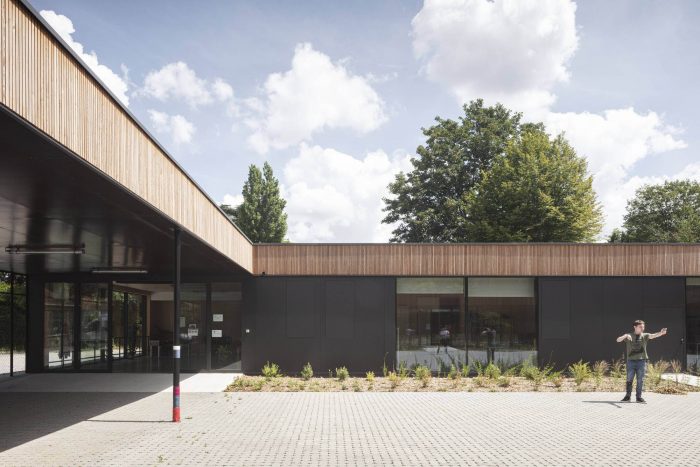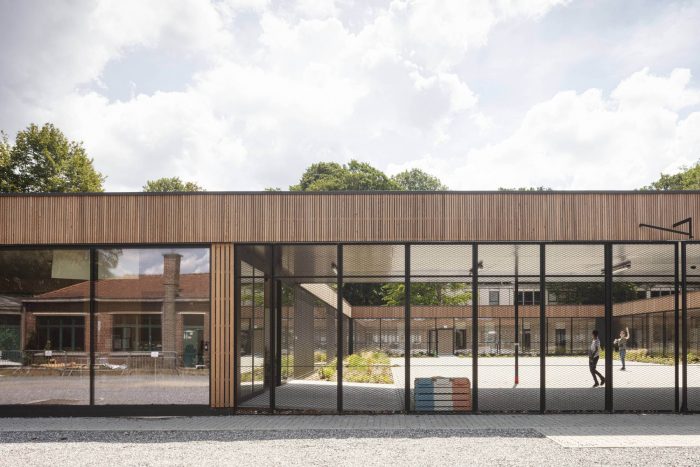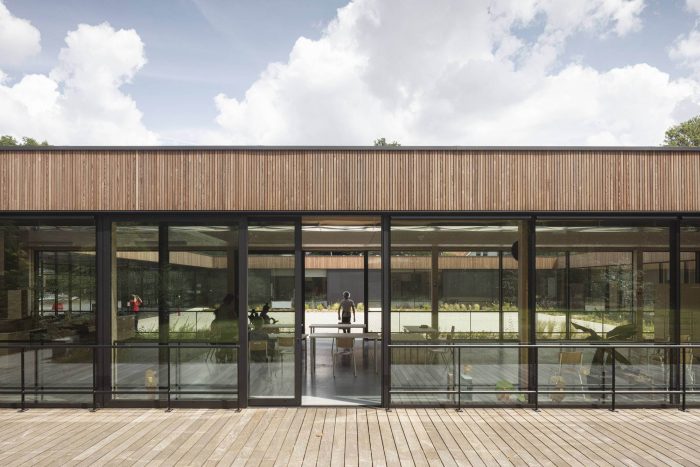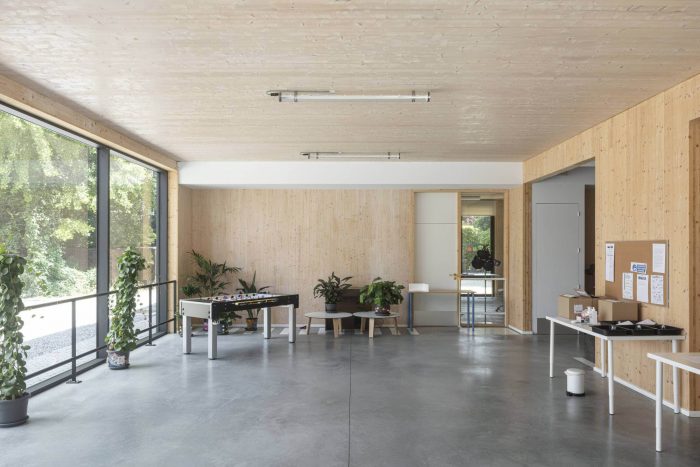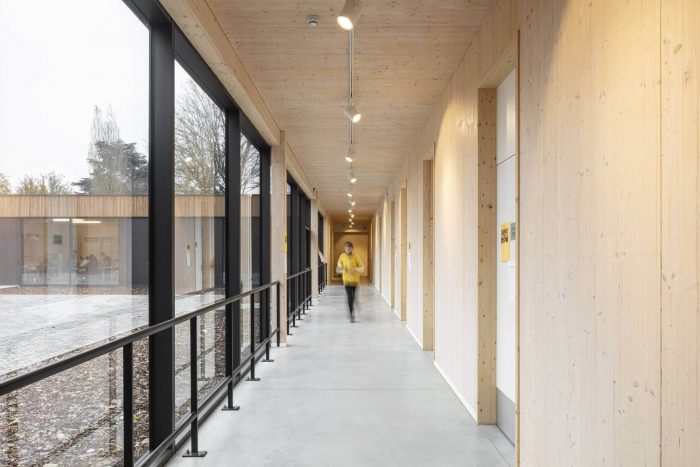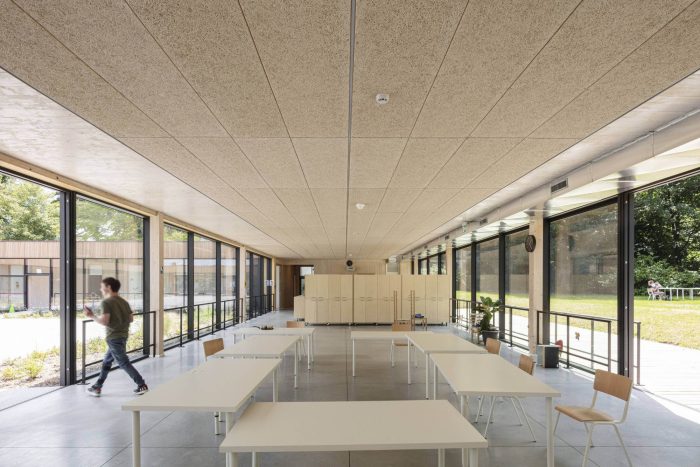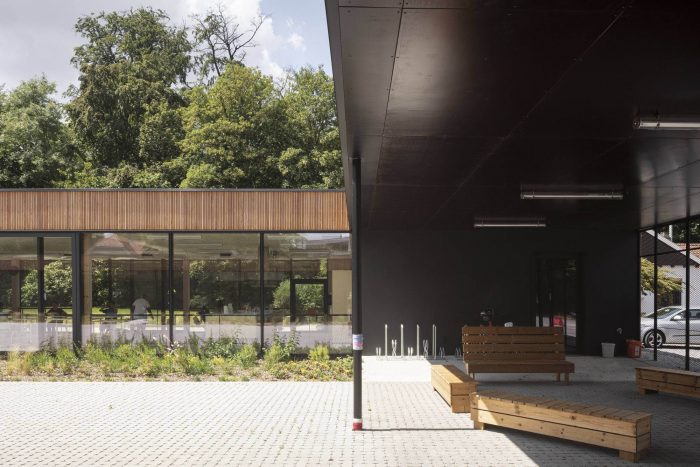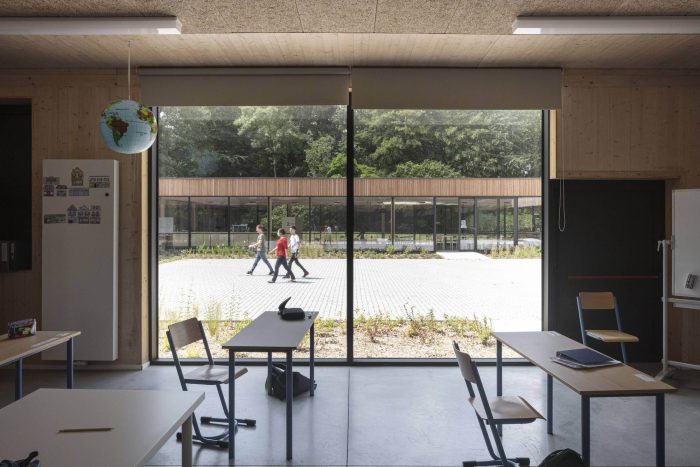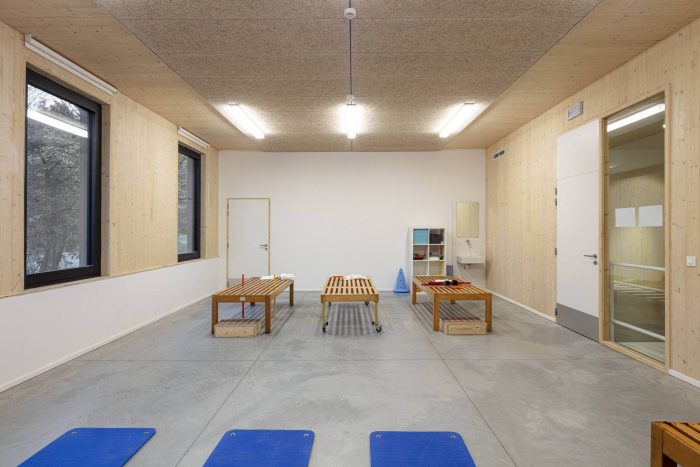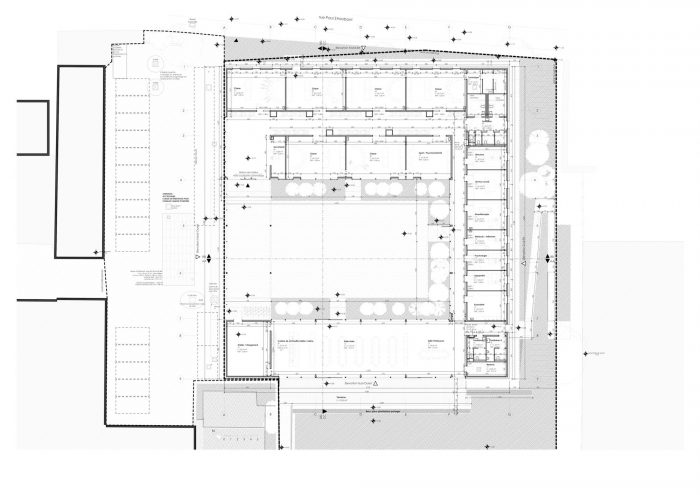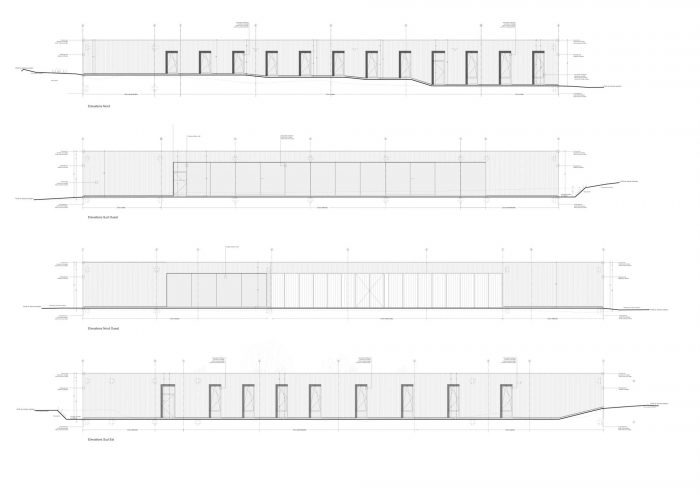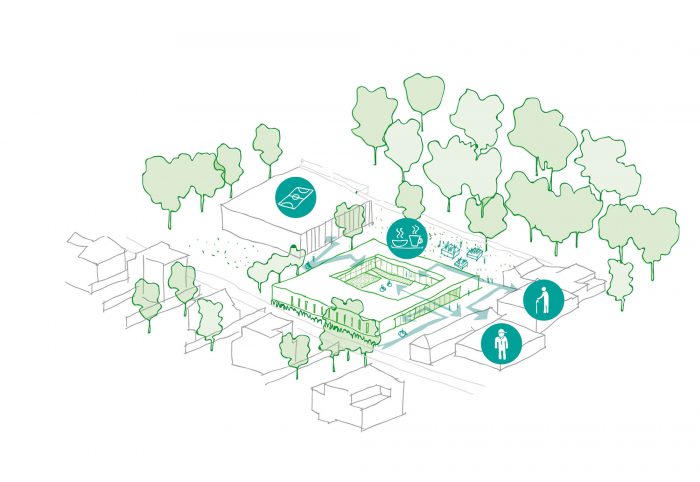一群有运动障碍儿童的家长是这所学校项目的起源。他们在布鲁塞尔大区为他们的孩子寻找一所具有传导教学法的高中,他们得出结论,如果他们想拥有一所这样的学校,就必须自己建造。他们与LA CIME学校合作实现了这一目标,并联系了建筑师A229来设计这所未来的学校。
A group of parents with children with motor disability is at the origin of this school’s project. Looking for a high school with conductive pedagogy in the Brussels Region for their children, they concluded that if they wanted one, they would have to build it themselves. They teamed up with LA CIME school to make it possible and contacted the architects A229 to design the future school.
未来的使用者、家长、建筑师、工程师、公共管理部门和建筑公司在一个真正的共同创造过程中合作,使学校建设在计划的预算和时间内成为可能:整个项目在8个月内建成,为新学年的开始做好准备。该项目位于一个绝佳的地点,毗邻历史悠久的Wolvendael公园,位于一条平静的街道上。
Future users, parents, architects, engineers, public administration, and the construction company worked together in a real process of co-creation, making possible the school construction within the planned budget and timing: the whole project was built in 8 months, ready for the start of the school year. The project is located on a wonderful site, next to the historical Wolvendael Park, on a calm street.
几个公共建筑和私人别墅是它的直接邻居。该项目尊重其环境,并尽可能少地干扰公园和现有建筑之间的平衡。建筑物的低矮将促进其融合,并使附近的居民尽可能地保持对公园的看法。该项目包括建立一所新的第四类(运动障碍)中学(具有不同的监督、适应性方法和特殊工具的中学教育)。
Several public buildings and private villas are its direct neighbours. The project respects its context and disturbs as little as possible the balances established between the park and the existing constructions. The low height of the building will promote its integration and allow the neighborhood to keep as much as possible the views towards the park. The project consisted of the creation of a new type 4 (motor disability) secondary school (secondary education with different supervision, an adapted methodology, and specific tools).
学生的行动能力下降,每个班级最多只能容纳8名学生。学校必须能够容纳多达50名学生和35名不同类别的专业人员。一个日托中心与同一建筑以及一个多功能的餐厅融为一体,在非上课时间,它可以被市政当局用于活动或作为公园的食堂。这个混合项目统一在一个简单而有效的规划中:四个酒吧,每个酒吧都有自己的特色,围绕着一个中央开放的空间,就像一个大庭院的房子:–学校:灵活的教室和一个大而活泼的走廊–日托中心:一个明亮的走廊,向庭院开放,可以进入办公室和治疗室–餐厅:一个宽阔的空间,没有柱子,完全向庭院和公园提供玻璃。开放式的厨房和可移动的家具有助于实现不同的空间布局。- 门廊:屋顶保护了庭院的一部分,使其免受雨水的侵袭,并形成了学校的入口。精心设计的角度可以容纳服务区(洗手间,技术室),同时保持与外部的视觉联系。
The students present reduced mobility and there will be a maximum of 8 per class. The school had to be able to accommodate up to 50 students and 35 professionals of different categories. A daycare centre is integrated with the same building as well as a dining hall which is multi-purpose, and which could be used by the municipality for events or as a cafeteria for the park, during non-school hours. This mixed program is unified in a simple and efficient plan: four bars, each one presenting its own character, are assembled around a central open space, like a big courtyard house: – The school: flexible classrooms and a large and lively corridor – The daycare centre: a bright corridor open to the courtyard gives access to the offices and therapy rooms – The dining room: a wide space, free of columns and fully glazed towards the courtyard and the park. An open kitchen and movable furniture help allow different spatial layouts. – The porch: a roof protecting part of the courtyard from the rain and creating the entrance to the school Angles are carefully designed to accommodate service areas (restrooms, technical rooms) while keeping visual connexions with the outside.
整个项目被设想为一个友好的生活场所,是用户真正的家。指导设计的主要目标是:在原有学校的基础上建造新学校,减少对场地通透性的影响,将建筑设计在一层,以尽可能方便行动不便的学生通行。
The whole project is conceived as a friendly place to live, a real home for its users. The main aims that guided the design are: building the new school over the existing footprint of a former school, reducing the impact on the permeability of the site, conceiving a building on one single level, in order to facilitate the circulation of the students with reduced mobility as much as possible.
整个建筑是无障碍的,特殊的行动要求不被看作是限制,而是机会。- 提供高质量的内部空间,尽可能的多功能,以便能够随着时间的推移而变化,并最大限度地利用自然光。- 营造友好的氛围,并通过材料将建筑与环境融为一体:大量的木质结构(CLT)给室内带来温暖的感觉,木质覆层将建筑与周围的自然环境融为一体。
The whole building is universally accessible, special mobility requests are not seen as constraints but as opportunities. – Offering quality interior spaces, as versatile as possible in order to be able to evolve over time, and with a maximum of natural light. – Creating friendly atmospheres and integrating the building into its context thanks to the materials were chosen: massive wood structure (CLT) gives a warm feeling to the interiors and wooden cladding melts the building into the nature of its surroundings.
该项目以其经济性为特点:裸露的材料(木材、混凝土)、克制的色调、简单的技术设施。- 提供优质的户外空间。建筑的 “方形甜甜圈 “形状定义了一个安全的庭院,适合其使用者。食堂通向一个私人花园,在视觉上与邻近的Wolvendael公园相连。- 促进社会协同作用。通过利用其环境的优势,并通过强调靠近一所小学、一个老年人日托中心和Wolvendael公园。学校的一部分可以在课余时间用于各种活动。
The project is characterised by its economy of means: exposed materials (wood, concrete), restrained palette, simple technical facilities. – Providing quality outdoor spaces. The “square doughnut” shape of the building defines a secure courtyard, suitable for its users. The refectory opens onto a private garden, which is connected visually with the neighbouring Wolvendael park. – Promoting a social synergy. By taking advantage of its context and by highlighting the proximity of a primary school, a daycare centre for the elderly, and the Wolvendael park. Part of the school can be used outside of school hours for various activities.
建筑师:ATELIER 229
面积:1400 m²
年份:2019年
摄影:Tim Van de Velde
首席建筑师:Jaime Eizaguirre, Marta Vélez Reznak
城市:Uccle
国家:比利时
Architects: ATELIER 229
Area: 1400 m²
Year: 2019
Photographs: Tim Van de Velde
Lead Architects:Jaime Eizaguirre, Marta Vélez Reznak
City:Uccle
Country:Belgium


